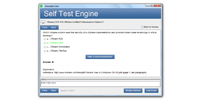さまざまな記憶方法
毎日新しい知識を学んでいるだけでなく、常に忘れられていた知識も私たちは記憶と鍛造の過程にあったと言うことができます。 これには優れたメモリアプローチが必要です、そしてGB0-371-ENU研究の脳ダンプはそれを上手く行います。GB0-371-ENU準備ガイドは、テキスト、画像、グラフィックメモリ方式などの多様化を採用し、情報を学ぶためにマークアップを区別する必要があります。 全体的なレイアウト、目標とされた長期記憶の形成へのより良い手がかり、そして実践のサイクルを通して、知識をより深く私の頭の中に印刷させてください。GB0-371-ENU試験問題は非常に科学的かつ妥当であり、あなたは簡単にすべてを覚えることができます。
便利なPDFダウンロードモード
ユーザーのオフラインでの読解を容易にするために、GB0-371-ENU学習問題集は、特にユーザー向けのPDFモードを開発するために、破片の時間を学習に使用することができます。 このモードでは、ユーザーはダウンロードして印刷すること、紙にメモを取ることが簡単であること、および自分の記憶の弱いリンクを学ぶために、教材内のGB0-371-ENU準備ガイドを知ることができます。 我々のGB0-371-ENU試験問題とユーザの効率を非常に改善します。 あるいは、いわゆる「いい」を忘れてしまうかもしれませんが、今ではオンラインで読むのに便利なあらゆる種類のデジタル機器ですが、私たちの多くは、彼らの記憶パターンを深めるために書面で使われています。 私たちのGB0-371-ENU準備ガイドは、この点でユーザーの需要を満たすのに非常に良いものです。ユーザーが良い環境で読み書きできるようにすることで、学んだことを継続的に統合することができます。
強力なユーザー共有プラットフォーム
もちろん、個人的な学習効果は特に目立ちません。なぜなら、この問題を解決するために、テストの難点、良いアップデートを同時に得られないという最新の試験の傾向を掴むのは難しいからです。 圧倒的多数のユーザーのためのGB0-371-ENU研究問題集は、ユーザーが共有するための強力なプラットフォームを提供します。 ここでは、GB0-371-ENU試験問題のすべてのユーザが自分のID番号を通してプラットフォームと他のユーザにログオンして共有し交換することができ、プラットフォーム上でさらに仲良くなるために多くの人々と努力することができます。 他の、学習や生活の中で彼らの困難を解決するためにお互い。GB0-371-ENU準備ガイドは、学習環境だけでなく、家庭のような学習環境を作成することもできます。
私たちのGB0-371-ENU研究の問題集は、この点でユーザの要求を満たすのに非常に役立ちます。GB0-371-ENU準備ガイドは高品質です。 それでテストの準備をするためのすべての効果的な中心的な習慣があります。 私たちの職業的能力により、GB0-371-ENU試験問題を編集するのに必要なテストポイントに同意することができます。 それはあなたの難しさを解決するための試験の中心を指しています。 だから高品質の材料はあなたが効果的にあなたの試験に合格し、目標を達成するために簡単に感じるようにすることができます。
H3C Constructing H3C High-Performance Campus Networks 認定 GB0-371-ENU 試験問題:
1. Regarding the role and status of the STP port, the following statements are correct:
A) The port with the role of Alternate will not go through the Listening state and the Learning state
B) Only the Alternate port will be in the Blocking state
C) Only the designated port will eventually be in the Forwardig state
D) The designated port will enter the Forwarding state after two ForwardDelay durations
2. In the switching network as shown in the figure, all three switches only have the default VLAN1, the interconnection ports of the three switches are trunks, and all VLANs are allowed to pass, and the three switches have the global and port GVRP functions enabled. VLAN 10 is created on the switch SWA, VLAN 20 is created on the switch SWC, and the GVRP registration mode of the Ethernet 1/0/1 port is set to Fixed on the switch SWA, and the display vlan command is executed on the SWB to view the VLAN existing on VLASWB ( Select one or more)
A) VLAN1
B) VLAN20
C) VLAN 10
3. Among the following PIMV2 messages, the destination address is a unicast address:
A) Graft
B) Hello
C) Assert
D) Prune
E) Register
F) Join
4. As shown in the picture, SWA, SWB and SWC enable STP, and the MAC address of SWB is less than the MAC address of SWA. If the topology converges and the bridge priority of SWB is set to 0, the following statements are correct.
A) SWA will immediately determine that port E0/1 is the root port
B) After SWC receives the configuration BPDU sent by SWB, it will not update immediately, but will wait for the locally saved configuration BPDU to age before updating
C) The topology will re-converge after 30 seconds by default
D) After the priority is adjusted, SWB will immediately send configuration BPDUs with itself as the root from ports E0/1 and E0/2
5. When the IGMPV3 host wishes to leave the multicast group G, the host will actively send a Membership Report message, and the group record contained in the message is
A) TO_IN (Null, G)
B) TO_EX (A, G)
C) TO_IN (A, G)
D) TO_EX (Null, G)
質問と回答:
| 質問 # 1 正解: A、B、D | 質問 # 2 正解: A、B、C | 質問 # 3 正解: A、E | 質問 # 4 正解: A、C、D | 質問 # 5 正解: A |


 288 お客様のコメント
288 お客様のコメント





